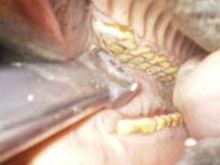Quick facts
- Schedule yearly dental exams for your horse.
- Include floating in your horse’s routine veterinary care.
- Watch for signs of sharp points and discomfort.
Have your veterinarian routinely check your horse’s teeth
No horse owner wants to see their horse in pain. Dental pain can sometimes be hard to identify, but it can greatly affect your horse's overall health.
You should have your horse's teeth checked yearly, even if you don’t notice any problems.
Some horses may require annual dental floating (filing down of sharp edges on teeth), especially if they have an overbite or underbite.
Older horses may have loose teeth that require pulling. While younger horses may need baby or wolf teeth removed.
Working with a veterinarian can help you identify and address serious dental problems.
Signs of serious dental problems:
- Quidding - horse spits or lets food fall out of its mouth
- Foul smelling breath
- Weight loss
- Refusing to chew hay
- Nasal discharge
- Pus seeping from the sides of the cheek or below the jaw
- Refusal to accept the bit
- Head shaking
Signs of advanced dental disease:
- Reddening of the gums (gingivitis)
- Packing of feed between teeth
- Broken or missing teeth
Signs your horse has sharp enamel points
- Ulcers on the tongue and cheek lining
- May cause pain during eating or riding
- Tilting of the head to one side while eating
- Quidding: dropping clumps of hay or grain from their mouth
- Dropping a lot of grain from their mouth while chewing
- Weight loss
- Can result from a decrease in feed intake due to dropping grain
- Inability to chew feed
- Can lead to poor digestion and possibly intestinal impaction, colic, or chronic esophageal choke
How do sharp enamel points develop?
Your horse’s teeth continue to grow throughout its life but they wear down by contact with other teeth.
The horse’s upper jaw is wider than its lower jaw. As a result, the outer aspect of the upper teeth don’t directly contact the lower teeth.
Likewise, the inside surface of the lower teeth don’t directly contact the upper teeth. Both of these factors result in sharp points over time.
What is floating?
Floating is filing down the sharp enamel points on the buccal and lingual. The buccal is the cheek surface of the upper teeth. The lingual is the tongue surface of the lower teeth.
Enamel points develop naturally over time. But floating teeth should be a basic part of your horse's routine veterinary care.
In Minnesota, licensed veterinarians can float teeth. Non-veterinarians may float teeth under the direct supervision of a veterinarian.
Identifying root problems
Radiographs can help determine if there is a problem with a tooth below the gum line. Digital radiographs can reveal issues with the tooth root and supporting bone.
At specialty centers, intra-oral radiographs are even better at identifying early tooth and tooth root changes that may indicate the need for root canal treatment or tooth removal.
Hypercementosis
With hypercementosis, a horse's incisors or canine teeth appear to have plaque build-up. A bumpy appearance will develop under the gum line. Tooth roots may partially dissolve. Horses may resist the bit or refuse to eat due to the intense pain.
The treatment includes removal of the affected incisors, which isn’t always an easy task.
Removing teeth
Veterinarians remove teeth through the mouth. This method is the safest because veterinarians can use specialized nerve blocks and equipment while the horse stands sedated.
Horses with broken teeth may undergo surgical removal using general anesthesia if necessary. Many avoid this method due to high complication rates.
Reviewed in 2021



